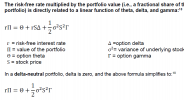Hi all,
Looking for a formula that depicts the relationship between all the option greeks; delta, gamma, vega, theta, and rho.
For example, the portfolio value *rf formula (below) is extremely useful for theta/delta/gamma/vega relationship (assuming non-delta neutral portfolio).
Such that I'm easily able to transpose to make any of them the subject, to derive a relationship.
Wanted to know if there was another formula that incorporates rho as well?

Looking for a formula that depicts the relationship between all the option greeks; delta, gamma, vega, theta, and rho.
For example, the portfolio value *rf formula (below) is extremely useful for theta/delta/gamma/vega relationship (assuming non-delta neutral portfolio).
Such that I'm easily able to transpose to make any of them the subject, to derive a relationship.
Wanted to know if there was another formula that incorporates rho as well?

